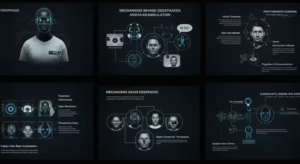AI and Fake News: Fighting Disinformation in the Digital Age

The blog post AI and Fake News: Fighting Disinformation in the Digital Age explores the intricate relationship between AI fake news and the evolving digital landscape. It begins by providing an understanding of how AI technologies contribute to the proliferation of fake news, particularly through sophisticated deepfakes and media manipulation techniques. The article highlights the mechanisms behind these tools and examines the effectiveness of AI-driven fact-checking tools designed to counteract misinformation. Furthermore, it outlines essential steps for individuals and organizations to combat disinformation in today’s post-truth era, emphasizing the need for awareness and proactive measures. By addressing the challenges posed by AI fake news, the post aims to empower readers with the knowledge necessary to navigate the complexities of digital information and contribute to a more informed society.
Understanding AI And Fake News In The Digital Landscape

The proliferation of AI fake news presents a significant challenge in today’s digital landscape. As artificial intelligence evolves, it empowers individuals and organizations to create increasingly realistic and misleading content. This manipulation of information can have far-reaching consequences on public opinion, trust in media sources, and even the democratic process. Recognizing the implications of AI-generated disinformation is crucial for effective engagement and response strategies.
Key Points to Consider:
- AI technology can enhance the creation of fake news, making it more challenging to discern truth from fiction.
- Detection mechanisms, such as disinformation detection tools, are vital to countering the effects of AI-generated falsehoods.
- The rapid spread of AI fake news often relies on social media platforms, amplifying its reach.
- Educating the public on identifying fake news can empower individuals to critically assess information.
- Collaborations between tech companies and regulatory bodies can enhance accountability in content creation.
- Regular updates to detection algorithms are necessary to keep up with the evolving techniques of misinformation.
- Media literacy programs can play a crucial role in curbing the impact of disinformation.
Moreover, the integration of advanced analytics and machine learning can significantly improve our ability to identify disinformation detection methods. By leveraging AI to analyze patterns in data and content dissemination, we can uncover the origins of fake news and understand the tactics employed by those who spread it. This proactive approach not only aids in immediate identification but also works toward long-term solutions by informing better practices and policies in digital media.
Mechanisms Behind Deepfakes And Media Manipulation

Deepfakes and media manipulation represent a significant challenge in the digital landscape, particularly as AI fake news continues to proliferate. These technologies leverage advanced machine learning algorithms to create realistic yet misleading audio and video content. By synthesizing visual appearances and sounds, deepfakes can easily distort reality, making it challenging for audiences to discern authentic media from fabricated versions. This manipulation can have serious implications for public opinion, trust in journalism, and even political processes.
The rise of deepfakes is indicative of a larger trend in media manipulation, where the line between truth and fabrication becomes increasingly blurred. With the growing sophistication of the tools used to create deepfakes, the potential for misinformation has reached unprecedented levels. As more individuals rely on social media platforms for news consumption, the threat of media manipulation becomes even more critical. Ensuring the integrity of information is vital for maintaining informed societies and collective decision-making.
| Type of Media Manipulation | Description | Impact Level |
|---|---|---|
| Deepfakes | AI-generated videos that can alter appearances and speech. | High |
| Misinformation | False information spread without intent to deceive. | Medium |
| Disinformation | False information spread with the intent to deceive. | High |
| Algorithmic Bias | Failure of algorithms to accurately represent diverse perspectives. | Medium |
To further understand how one can engage with and combat these challenges, it is critical to recognize methods for identifying deepfakes effectively. The growing need for education around identifying such content is paramount for counteracting AI fake news. Informed viewers and consumers can better navigate this landscape and raise awareness about the implications of media manipulation
Steps to Identify Deepfakes:
- Check the source: Verify the credibility of the media outlet sharing the content.
- Consider the context: Analyze the circumstances in which the media was shared.
- Examine visual inconsistencies: Look for unnatural movements, blurring, or glitches in the video.
- Listen for audio anomalies: Assess if the audio track matches the person’s lip movements and tone.
- Utilize technology: Employ apps and browser extensions designed to detect deepfakes.
- Consult experts: Engage with fact-checkers or media professionals for clarity.
- Spread awareness: Share your findings about deepfakes and media manipulation to educate others.
Detection Techniques
Various detection techniques have emerged to combat the challenges posed by deepfakes and enhance the credibility of online information. These techniques often harness machine learning algorithms designed to spot the telltale signs of manipulated media. With advancements in computer vision and forensic analysis, there are dedicated tools that analyze visual integrity and flag suspicious content for further scrutiny.
Case Studies of Deepfake Impact
Real-world case studies illustrate the profound impact deepfakes have had on public perception and reaction. For example, high-profile incidents involving political figures and celebrities have demonstrated how seemingly authentic videos can influence electoral outcomes and public opinion. The ripple effects of these manipulated media instances highlight the urgent need for comprehensive strategies to address deepfakes and broader media manipulation.
AI Fact-Checking Tools And Their Effectiveness

The rise of AI in fact-checking has transformed how we tackle the increasing issue of fake news and disinformation. AI fact-checking tools leverage sophisticated algorithms to analyze vast amounts of data in real-time, providing users with timely information. This capability is essential in today’s fast-paced digital landscape, where misinformation spreads rapidly across various platforms. The integration of AI in disinformation detection not only enhances the speed at which false claims are addressed but also improves the reliability of the sources by scrutinizing information effectively.
As the challenge of fake news evolves, the effectiveness of AI fact-checking tools becomes a focal point for researchers and tech developers. These tools must balance thoroughness and speed to ensure accurate results without overwhelming users. Additionally, it is crucial that these AI-driven solutions are designed with user experience in mind, minimizing complexity while maximizing transparency in how they operate. The goal is to equip individuals with the ability to discern credible information from deceptive narratives.
| Tool Name | Key Features | Effectiveness Rating (1-10) |
|---|---|---|
| FactCheckAI | Real-time data analysis, source verification | 9 |
| ClaimBuster | Contextual claims evaluation, user-friendly interface | 8 |
| FullFact | Collaborative fact-checking, social media integration | 7 |
| Snopes | Legacy database, community contributions | 8 |
The effectiveness of these AI fact-checking tools is often measured by their ability to provide accurate information and adapt to various types of disinformation. As they evolve, so does the variety of their applications. This adaptability is vital as misinformation continues to evolve, with new tactics emerging regularly. Understanding the specific functionalities of each tool can help organizations and individuals choose the best fit for their needs, ensuring robust defenses against the threat of fake news.
Benefits of Using AI Fact-Checking Tools:
- Rapid detection of misinformation
- Ability to analyze large datasets quickly
- Enhanced accuracy over manual fact-checking
- Improved user trust in shared content
- Scalability in handling multiple cases simultaneously
- Integration with social media platforms
Ultimately, the implementation of AI fact-checking tools stands as a pivotal strategy in the broader fight against disinformation. They not only empower users with knowledge but also help cultivate a more informed public discourse. As these tools continue to advance, their potential to significantly impact the landscape of information dissemination will become increasingly evident.
Steps To Combat Disinformation In The Post-Truth Era

As we navigate the complexities of the digital age, combatting disinformation is paramount. The rise of AI fake news demands a proactive approach to mitigate its impact. To effectively address this phenomenon, recognizing the nuances of disinformation detection is essential. By leveraging technology and enhancing public awareness, we can muster a collective response against the proliferation of false narratives.
Actionable Strategies to Take Action:
- Employ AI tools to analyze and flag potential disinformation sources.
- Educate the public on the signs of fake news and disinformation.
- Encourage critical thinking and media literacy in educational curriculums.
- Promote transparent practices among content creators and influencers.
- Collaborate with tech companies to improve algorithms for fact-checking.
- Engage in community discussions to cultivate a skeptical approach towards unverified information.
- Support policies that enhance accountability for disseminators of false information.
By implementing these strategies, individuals and organizations can play a pivotal role in fighting the spread of AI fake news. Each action contributes to a more informed society, equipped to discern truths from fabrications. Furthermore, a holistic approach that includes collaboration among stakeholders is necessary to create an environment resistant to manipulation.
To effectively fight disinformation, it’s crucial to equip ourselves with the knowledge and tools necessary to identify and counter fake narratives.
Ultimately, while disinformation detection technologies are advancing rapidly, they must be complemented by an informed and engaged public. As we foster a culture that values truth and accountability, we can reduce the impact of AI-generated misinformation, paving the way for a healthier digital information landscape.
Briefing Document: AI and Fake News – Fighting Disinformation in the Digital Age
1. Executive Summary
This document summarizes key insights from the provided source regarding the intersection of Artificial Intelligence (AI) and the proliferation of fake news. The source highlights how AI technologies, particularly deepfakes and media manipulation techniques, contribute to the spread of misinformation, posing significant challenges to public opinion, trust in media, and democratic processes. It emphasizes the critical role of AI-driven fact-checking tools in combating disinformation and outlines essential steps for individuals and organizations to navigate and counteract this threat in the “post-truth era.” The overarching theme is the urgent need for awareness, proactive measures, and a multi-faceted approach combining technological solutions, education, and policy to foster a more informed society.
2. Main Themes and Key Ideas
2.1. AI’s Role in Amplifying Fake News and Disinformation
- Sophisticated Content Creation: AI significantly enhances the creation of fake news, making it “more challenging to discern truth from fiction.” This is primarily achieved through “sophisticated deepfakes and media manipulation techniques.”
- Deepfakes as a Major Threat: Deepfakes leverage advanced machine learning to create “realistic yet misleading audio and video content” that can “easily distort reality.” This has “serious implications for public opinion, trust in journalism, and even political processes.”
- Blurred Lines: The rise of deepfakes signifies a “larger trend in media manipulation, where the line between truth and fabrication becomes increasingly blurred.”
- Rapid Spread via Social Media: The “rapid spread of AI fake news often relies on social media platforms, amplifying its reach.”
2.2. Mechanisms of Media Manipulation
The source categorizes media manipulation, highlighting their impact:
- Deepfakes: “AI-generated videos that can alter appearances and speech.” (Impact Level: High)
- Misinformation: “False information spread without intent to deceive.” (Impact Level: Medium)
- Disinformation: “False information spread with the intent to deceive.” (Impact Level: High)
- Algorithmic Bias: “Failure of algorithms to accurately represent diverse perspectives.” (Impact Level: Medium)
2.3. The Promise and Effectiveness of AI Fact-Checking Tools
- Real-time Analysis: AI fact-checking tools utilize “sophisticated algorithms to analyze vast amounts of data in real-time, providing users with timely information.”
- Enhanced Speed and Reliability: AI integration “enhances the speed at which false claims are addressed but also improves the reliability of the sources by scrutinizing information effectively.”
- Key Benefits:“Rapid detection of misinformation”
- “Ability to analyze large datasets quickly”
- “Enhanced accuracy over manual fact-checking”
- “Improved user trust in shared content”
- “Scalability in handling multiple cases simultaneously”
- “Integration with social media platforms”
- Tool Examples and Effectiveness:FactCheckAI: “Real-time data analysis, source verification” (Effectiveness Rating: 9/10)
- ClaimBuster: “Contextual claims evaluation, user-friendly interface” (Effectiveness Rating: 8/10)
- FullFact: “Collaborative fact-checking, social media integration” (Effectiveness Rating: 7/10)
- Snopes: “Legacy database, community contributions” (Effectiveness Rating: 8/10)
- Adaptability is Key: The effectiveness of these tools relies on their “ability to provide accurate information and adapt to various types of disinformation” as misinformation tactics evolve.
2.4. Comprehensive Strategies to Combat Disinformation
Combatting disinformation in the “post-truth era” requires a multi-pronged approach that combines technological solutions with public education and policy:
- Leveraging AI for Detection: “Employ AI tools to analyze and flag potential disinformation sources.” Regular updates to detection algorithms are “necessary to keep up with the evolving techniques of misinformation.”
- Public Education and Media Literacy:“Educate the public on the signs of fake news and disinformation.”
- “Encourage critical thinking and media literacy in educational curriculums.”
- Media literacy programs “can play a crucial role in curbing the impact of disinformation.”
- “Informed viewers and consumers can better navigate this landscape and raise awareness about the implications of media manipulation.”
- Collaboration and Accountability:“Collaborations between tech companies and regulatory bodies can enhance accountability in content creation.”
- “Collaborate with tech companies to improve algorithms for fact-checking.”
- “Promote transparent practices among content creators and influencers.”
- “Support policies that enhance accountability for disseminators of false information.”
- Individual Action: Individuals are encouraged to take proactive steps, including verifying sources, considering context, examining inconsistencies in visual/audio content, utilizing detection technology, consulting experts, and “Spread awareness: Share your findings about deepfakes and media manipulation to educate others.”
- Holistic Approach: While “disinformation detection technologies are advancing rapidly, they must be complemented by an informed and engaged public.” The ultimate goal is to “foster a culture that values truth and accountability.”
3. Most Important Ideas or Facts
- AI’s Dual Role: AI is both a primary driver of sophisticated fake news (especially deepfakes) and a crucial tool for its detection and combat.
- Deepfakes are a High-Impact Threat: Their ability to create “realistic yet misleading audio and video content” poses a significant risk to public trust and democratic processes. Case studies demonstrate their “profound impact on public perception and reaction.”
- Fact-Checking Tools are Essential but Evolving: AI-powered fact-checking offers rapid and accurate detection capabilities, but continuous adaptation and user-friendliness are vital for their sustained effectiveness.
- Public Awareness and Education are Paramount: Technology alone is insufficient. “Educating the public on identifying fake news can empower individuals to critically assess information.” Media literacy is a cornerstone of defense.
- Collaboration is Key: A united front involving tech companies, regulatory bodies, and the public is necessary to effectively “combat disinformation” and create a “healthier digital information landscape.”
- The “Post-Truth Era” Requires Proactive Measures: The ongoing challenge of disinformation necessitates a constant, evolving strategy, moving beyond reactive responses to proactive engagement and policy.
Artificial intelligence / humanaifuture.com
🎧 Listen to the Podcast
Want to explore this topic in more depth? Listen to the full podcast for more insights and expert commentary.
▶️ Play on Google DriveNo sign-up needed — just click and listen.
How do deepfakes and media manipulation work, and what are their impacts?
Deepfakes and media manipulation leverage advanced machine learning algorithms to synthesize realistic but fabricated audio and video content. This allows for the alteration of appearances and speech, making it challenging to discern authentic media from manipulated versions. The impact is high, as these technologies can influence electoral outcomes, public perception of political figures and celebrities, and generally blur the line between truth and fabrication, especially with the widespread use of social media for news consumption.
What are "disinformation detection" tools, and how do they work?
Disinformation detection tools are mechanisms, often leveraging AI and machine learning, designed to identify and counteract the effects of AI-generated falsehoods. These tools analyze patterns in data and content dissemination to uncover the origins of fake news and understand the tactics used to spread it. They aim for rapid identification and contribute to long-term solutions by informing better practices and policies in digital media.
How effective are AI fact-checking tools, and what are their benefits?
AI fact-checking tools are highly effective in combating fake news and disinformation by using sophisticated algorithms to analyze vast amounts of data in real-time. They can quickly detect misinformation, analyze large datasets, and offer enhanced accuracy compared to manual fact-checking. Key benefits include rapid detection, improved user trust in shared content, scalability in handling multiple cases simultaneously, and integration with social media platforms, all contributing to a more informed public discourse.
What are some key points to consider regarding the spread and impact of AI fake news?
Several key points highlight the nature and impact of AI fake news: AI technology enhances the creation of fake news, making truth harder to discern. Its rapid spread often relies on social media platforms, amplifying its reach. Detection mechanisms are crucial, and regular updates to algorithms are needed to keep pace with evolving misinformation techniques. Furthermore, educating the public on identification and fostering collaborations between tech companies and regulatory bodies are vital to enhancing accountability and curbing its impact.
What practical steps can individuals take to identify deepfakes?
Individuals can take several practical steps to identify deepfakes: checking the credibility of the media outlet sharing the content, analyzing the context in which the media was shared, examining visual inconsistencies like unnatural movements or glitches, listening for audio anomalies that don't match lip movements, utilizing apps or browser extensions designed for deepfake detection, consulting experts or fact-checkers, and spreading awareness about deepfakes and media manipulation to educate others.
What are the actionable strategies for individuals and organizations to combat disinformation in the post-truth era?
To combat disinformation, individuals and organizations should employ AI tools to analyze and flag potential disinformation sources, educate the public on the signs of fake news, and encourage critical thinking and media literacy in education. They should also promote transparent practices among content creators, collaborate with tech companies to improve fact-checking algorithms, engage in community discussions to foster skepticism towards unverified information, and support policies that enhance accountability for disseminators of false information.
Why is a holistic approach, combining technology and public engagement, crucial for fighting AI-generated misinformation?
A holistic approach, combining advancing disinformation detection technologies with an informed and engaged public, is crucial because while AI tools offer rapid and scalable solutions for identifying misinformation, they must be complemented by human awareness and critical thinking. Fostering a culture that values truth and accountability among the public helps reduce the impact of AI-generated misinformation, creating a more resilient and healthier digital information landscape that is resistant to manipulation.




